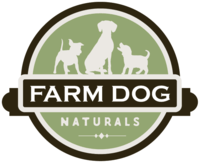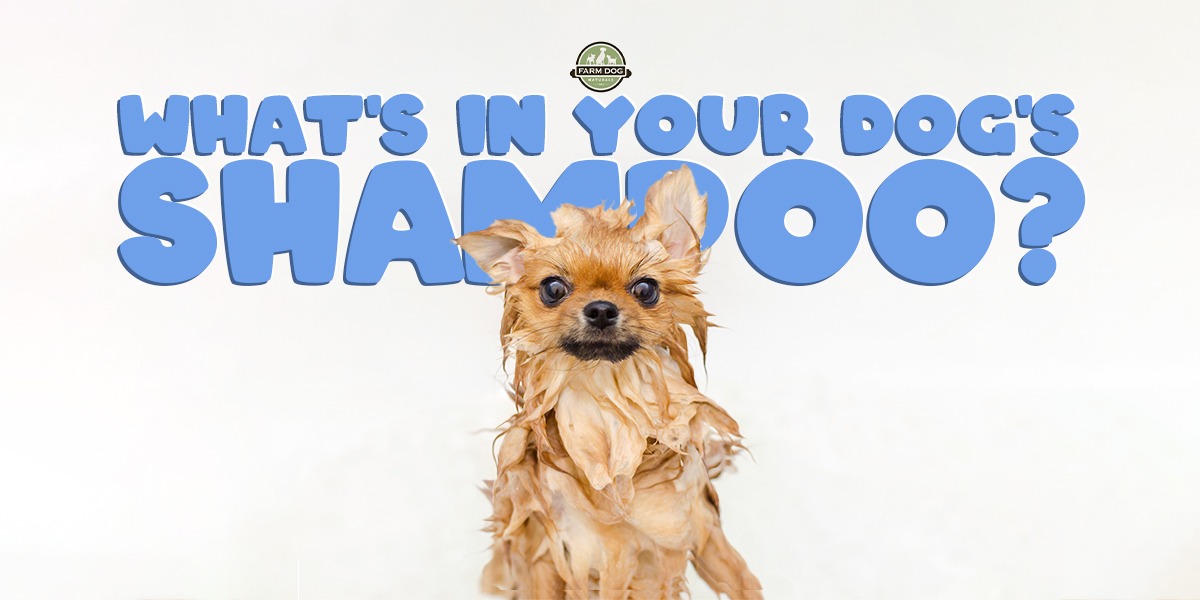We all have the best intentions when it comes to grooming our dogs. Bathing, brushing, trimming… we want them to look their best, smell their best, and most importantly, feel their best.
I recently visited a friend who bathes her dogs every week. I can’t imagine. To make matters worse, I made the mistake of looking at the ingredient list of her designer dog shampoo and almost fainted.
It looked like a bottle of toxic soup! How can she be my friend and use a toxic dog shampoo? Her answer was, “I use their products for myself, how can their dog shampoo be bad?”
I told her to switch shampoos ASAP. Again, she asked “Why?” Many shampoos are nothing but chemicals and toxins. Even many “natural” shampoos contain just a few natural extracts in them to make consumers think that by using their product you are somehow connecting with nature. Skilled marketing may work on some, but not on the informed consumer.
Your scalp and skin makes up your body’s largest and most absorbent organ. So your skin, and scalp, are the gateway to the bloodstream. This is also true for your beloved pup. Just think of their skin and hair follicles as one large scalp.
So what makes a shampoo toxic? A lot of things, actually…
15 Ingredients to Avoid in Dog Shampoo
1. Artificial Colors: Often dog shampoos that are supposed to be herbal come with a lovely green tint. Puree of leaf? Umm,no. Try artificial colors. Artificial colors have been associated with many forms of cancer. Avoiding them should be at the top of your to-do list. A few examples of these colors are D&C, FD&C, or Yellow 5.
2. Cocomide DEA or MEA: Notice this foam producing ingredient has the trendy “Coco” prefix that some would assume is coconut derived. The assumption would be right. What you may not realize is that this substance is chemically altered to the point of being a moderate cancer-causing ingredient, hormone and thyroid disruptor and an organ toxin. Yikes.
3. Cocamidopropyl Betaine: This ingredient sounds like a coconut who married a chemist. It is an environmental toxin that affects the immune system. It may be originally derived from coconut oil, but the end product is anything but.
4. Formaldehyde: Everyone’s favorite embalming elixir for the dead is now available in your shampoo. Do you feel lucky? Formaldehyde attacks the central nervous system. Look for it in your grooming products as doazolidinyl urea, imidazolidinyl urea, or quarternjum-15.
5. Fragrances: “Gee your hair smells terrific” was a slogan for a shampoo when I was a child. A good aroma can bring our senses alive and give us cause for purchasing a product based on smell alone. Unfortunately, if the aroma of a shampoo does not come from essential oils or plants, the smell is a derivative of an unhealthy substance. When picking a dog shampoo, we need to pay extra attention to scent because our canine friend’s sense of smell is 50 times more sensitive than ours. The word “fragrance” can be covering up chemicals that companies do not want you to know about. Artificial fragrances can lead to compromised immune function, allergic reactions, and neurotoxicity.
6. Isopropyl alcohol: Sneaky is the word for this gem. If you pay attention, isopropyl alcohol is showing up in all kinds of self and animal care products. DO NOT USE THEM. Known as rubbing alcohol, this chemical turns into acetone when it enters your body. It is a known depressant, nerve toxin, lung and heart irritant, and liver toxin. Other names: isopropanol, 2-propanol, and propyl.
7. Isopropyl (SD-40): This is made from the petroleum derived substance propylene that destroys your skins moisture balance and causes irritation. The nasty chemical can make you or your dog more susceptible to bacterial and viral infections.
8. Methylchloroisothiazolinone: This hard to pronounce chemical is added to shampoos as a preservative and an anti-fungal. It has been associated with organ poisoning and is a known carcinogen. The crazy thing is that countries like Japan and Canada have already banned it.
9. Methylparaben and Parabens: Members of the paraben family are usually found at the end of an ingredient label. Don’t be fooled. A little goes a long way. Both are used as preservatives. What companies don’t tell you is that they are known endocrine disruptors. Methylparaben might help protect your shampoo’s longevity, but it may also serve as an endocrine disruptor and may even adversely affect your central nervous system. Why is this significant? The two main parts of the central nervous system are the brain and spinal cord! What matters as far as your dog is concerned is that they can’t tell you when something is wrong. High levels of estrogens have also been linked to the paraben family. Elevated estrogens can cause cancers of the uterus, bladder and breast. Just say no.
10. Mineral Oil: I just cringe at this ingredient because Mr. Johnson sells it as something wonderful for babies. Mineral oil should be labeled “oil of crude” since it is a byproduct of distilled gasoline made from crude oil. Its sole purpose is to coat anything it comes in contact with and keep the skin from releasing its own natural oils or eliminating toxins.
11. Phthalates: Many shampoos are chosen for their scent. Phthalates help with the scenting of many soaps in that they bond the scent to the soap base. Like their friends the parabens, they are known male and female hormone disruptors.
12. Polyethylene glycol: Usually listed as PEG, polyethylene glycol is a known cancer-causing chemical used as a solvent in shampoos and conditioners. Here are a few of this chemical’s side effects: malabsorption of nutrients in the intestine, stomach disorders, iron deficiency, loss of memory, and immune dysfunction.
13. Polysorbates: Most people know the polysorbates for the number that follows. Polysorbate-20 and Polysorbate-80. These emulsifiers help bind oil with water and dissolve fragrances into a solution. Polysorbate 20 is a simple sugar alcohol that goes bad when it is mixed with the chemical ethylene oxide which can cause it to be contaminated with the cancer causing 1,4-dioxane. Polysorbates also mess with the pH of the skin, hair, or fur. Companies use polysorbates because they are cheap emulsifiers.
14. Propylene Glycol: Derived from natural gas and used in the automotive industry, propylene glycol is used as a humectant causing moisture retention by coating the hair shaft and preventing water from escaping. Propylene glycol is a strong skin irritant as well as a liver and kidney toxin.
15. Sodium Laureth Sulfate, Sodium Lauryl Sulfate, and Ammonium Laureth Sulfate: These chemicals capture oil and dirt so that they can be washed out of the hair shaft. Great, right? Well no. The sulfates also strip the hair of its natural oils and can cause skin irritations. With dogs, these irritations are not always noticed until they are infected because of their furry bodies. To make matters worse, sulfates are often put through a softening process that produces a toxic by-product discussed above; 1,4-dioxane, which the FDA does not require to be listed on the label. Both sodium and ammonium laureth sulfates are known cancer-causing agents.
Beware of the “Natural” Fakes
Just because it sounds natural, doesn’t mean that it is safe. Some “natural” shampoos and conditioners list “coconut base” as their first ingredient. Beware. Here are three of the best-selling coconut shampoo bases.
See if you can find the ingredients that don’t belong.
- Ingredients: Sodium Cocoate, Propylene Glycol, Sodium Stearate, Glycerin, Cocos Nucifera (Coconut) Fruit Juice, Water, Sorbitol, Titanium Dioxide.
- Ingredients: Purified Water | Propylene Glycol | Sodium Stearate | Glycerin | Sucrose | Sodium Laureth | Sodium Laureth Sulphate | Sorbitol | Sodium Lauryl Sulphate | Silica | Sodium Chloride | Stearic Acid | Lauric Acid | Methylchloroisothiazoline | Methylisothiazoline | Magnesium Chloride | Magnesium Nitrate (This base is advertised as sulfate free. Who cares when you see the other ingredients.)
- Ingredients: Glycerin, Propylene Glycol, Cocos Nucifera (Coconut) Oil, Sodium Cocoate, Sodium Myristate, Sodium Laurate, Sodium Stearate, Sorbitol, Purified Water
Not all “natural” products are created equal.
Finally, let me say a few things about conditioners. They are not needed for our dogs! I can’t believe the number of fur products that are marketed to our canine friends. A conditioner’s main purpose is to cover up the damage being done by the shampoo by replacing natural hair oils with artificial oils. Conditioners stay on the hair and get absorbed by your scalp. Think of how much fur your dog has compared to your hair! That is a lot of absorption.
How to Find a Safe Dog Shampoo
Look for simple shampoos that are made specifically for dogs. Remember, a dog’s pH is different than ours, so avoid shampoo for people.
To be sure you are using a good shampoo, ask companies for a complete listing of their ingredients. Don’t be satisfied with the general “coconut soap base”. Ask them what is in the base.
Here are a couple examples of all natural, safe shampoo bases:
- Ingredients: Certified Organic Coconut Oil*, Rosemary Extract, Vitamin E *Saponified. (Saponified means that the soap was made with Lye which does not survive the soap making process and it safe).
- Ingredients: Saponified Oils of Coconut, Olive and Jojoba, Tea Tree Oil, Rosemary Oil, Sage Oil Cedarwood Oil, Peppermint Oil, Sweet Orange Oil, Eucalyptus Oil, Pine Needle Oil, Aloe Vera, Rosemary Extract (as a preservative)
When washing my dogs I like to make my own dog shampoo out of castile soap, vinegar, olive oil, water and essential oils. It does not lather up like chemically laden commercial shampoos but it makes my dog’s fur squeaky clean and shiny.
Dogs are meant to be self cleaning. Dogs in the wild don’t bath but they are not living in our homes either. I have a dog named Seamus, a Schnoodle, half Schnauzer and a half poodle. He stinks. He has the kind of fur that soaks up every bad smell he comes in contact with. Seamus hates being bathed but in order to sleep in my bed, the stink must turn to stunk.
I encourage you to take control of your dog’s health and your own by reading the labels of your grooming products and demanding safer ingredients from manufactures. Dog shampoo and grooming products are not considered drugs, making them benign to FDA law. This is a loophole that manufacturers take advantage of. The term “all natural” is free for the taking. Want to protect yourself and your pup? Understand what is in your grooming products before you use them. Knowledge is power.

